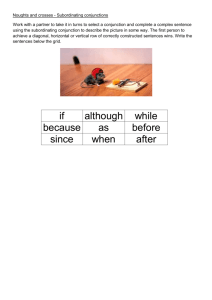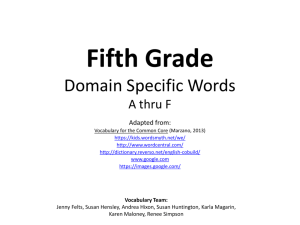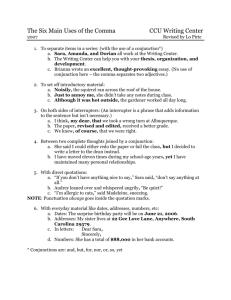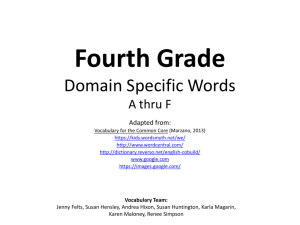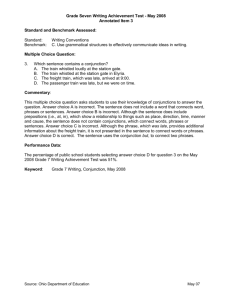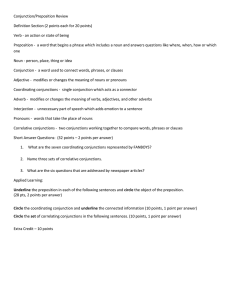COMPLEXITY OF THE DECIDABILITY OF ONE CLASS WITH A SET-UNION OPERATOR
advertisement
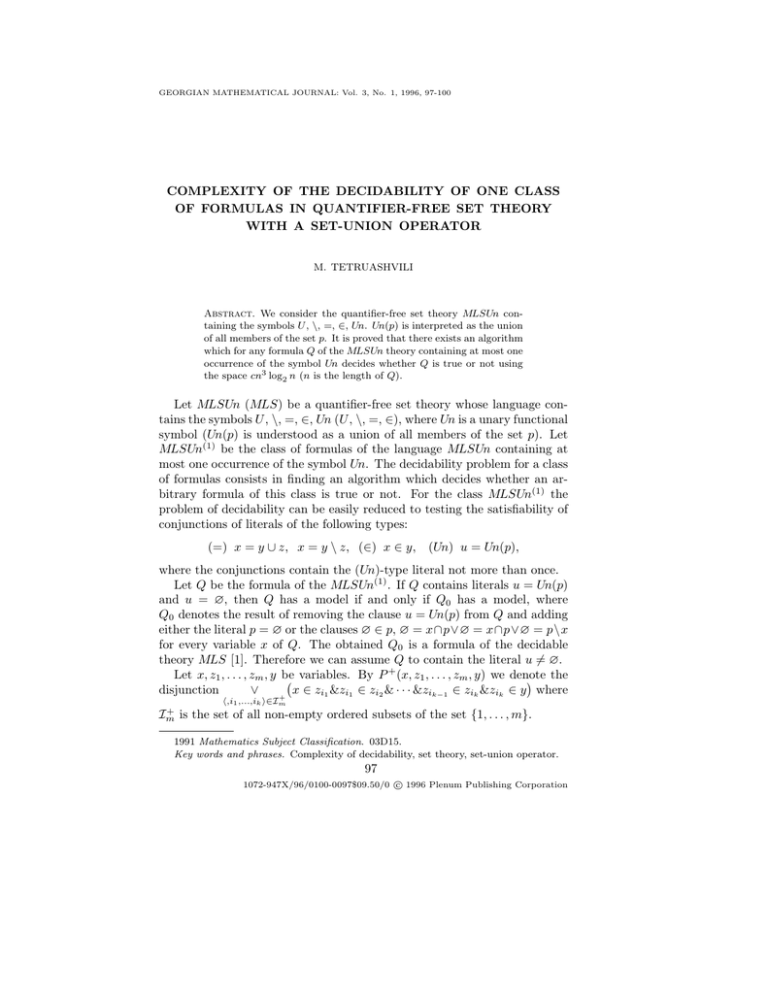
GEORGIAN MATHEMATICAL JOURNAL: Vol. 3, No. 1, 1996, 97-100
COMPLEXITY OF THE DECIDABILITY OF ONE CLASS
OF FORMULAS IN QUANTIFIER-FREE SET THEORY
WITH A SET-UNION OPERATOR
M. TETRUASHVILI
Abstract. We consider the quantifier-free set theory MLSUn containing the symbols U , \, =, ∈, Un. Un(p) is interpreted as the union
of all members of the set p. It is proved that there exists an algorithm
which for any formula Q of the MLSUn theory containing at most one
occurrence of the symbol Un decides whether Q is true or not using
the space cn3 log2 n (n is the length of Q).
Let MLSUn (MLS) be a quantifier-free set theory whose language contains the symbols U , \, =, ∈, Un (U , \, =, ∈), where Un is a unary functional
symbol (Un(p) is understood as a union of all members of the set p). Let
MLSUn(1) be the class of formulas of the language MLSUn containing at
most one occurrence of the symbol Un. The decidability problem for a class
of formulas consists in finding an algorithm which decides whether an arbitrary formula of this class is true or not. For the class MLSUn(1) the
problem of decidability can be easily reduced to testing the satisfiability of
conjunctions of literals of the following types:
(=) x = y ∪ z, x = y \ z, (∈) x ∈ y,
(Un) u = Un(p),
where the conjunctions contain the (Un)-type literal not more than once.
Let Q be the formula of the MLSUn(1) . If Q contains literals u = Un(p)
and u = ∅, then Q has a model if and only if Q0 has a model, where
Q0 denotes the result of removing the clause u = Un(p) from Q and adding
either the literal p = ∅ or the clauses ∅ ∈ p, ∅ = x∩p∨∅ = x∩p∨∅ = p\x
for every variable x of Q. The obtained Q0 is a formula of the decidable
theory MLS [1]. Therefore we can assume Q to contain the literal u 6= ∅.
+
Let x, z1 , . . . , zm , y be
variables. By P (x, z1 , . . . , zm , y) we denote
the
z
&z
∨
x
∈
&z
z
∈
∈
where
disjunction
∈
&
&z
z
y
·
·
·
i
i
i
i
i
i
1
1
2
k
k
k−1
+
h,i1 ,...,ik i∈Im
+
is the set of all non-empty ordered subsets of the set {1, . . . , m}.
Im
1991 Mathematics Subject Classification. 03D15.
Key words and phrases. Complexity of decidability, set theory, set-union operator.
97
c 1996 Plenum Publishing Corporation
1072-947X/96/0100-0097$09.50/0
98
M. TETRUASHVILI
Let x1 , . . . , xm be all variables occurring in Q. It is proved in [2] that
given a finite family z1 , . . . , zm of sets and the set p such that Un(p) 6= ∅,
there exists a non-empty set t ∈ p such that P + (t, z1 , . . . , zm , Un(p)) is false.
Therefore we can add the statements t ∈ p, t 6= ∅ and ¬P + (t, x1 , . . . , xm , u)
to the formula Q not modifying its satisfiability (t is a new variable).
Finally, Q can be assumed to contain one full conjunct C of the disjuncm
tive normal form (d.n.f.) of the statement & xi 6∈ p ∨ xi \ u = ∅ which is
i=1
true in any model of Q.
Let Q− denote the result of removing the literal u = Un(p) from Q.
The obtained Q− is a formula of MLS. It has been proved in [2] that
Q has a model if and only if Q− has a model. Therefore this theorem
solves the problem of decidability for the class MLSUn(1) . However, the
formula P + (x, z1 , . . . , zm , y) playing an important part in the investigation
+
) ≤ mm , and the d.n.f.
of satisfiability of Q is awkward: 2m ≤ Card(Im
of this formula contains a large number of summands (exponential with
respect to m).
Therefore the corresponding decidability procedure has an exponential
computational complexity (by space).
Below we shall find an algorithm which solves the decidability problem
for the class MLSUn(1) with a polynomial computational complexity (by
space).
The formula ¬P + (x, z1 , . . . , zm , y) is equivalent to the formula
&
zi1 ∨ zi1 6∈ zi2 ∨ · · · ∨ zik−1 6∈ zik ∨ zik 6∈ y .
x
∈
6
+
h,i1 ,...,ik i∈Im
2
Its d.n.f. ∆+ (x, z1 , . . . , zm , y) ≡ ∆+ contains at most mm summands.
Let K be an arbitrary summand of the above d.n.f. ∆+ . This K is a
conjunction of literals of the following forms: x 6∈ zi , zi 6∈ zj , zj 6∈ y. The
number of various ordered pairs composed of all variables of the formula
∆+ is less than (m + 2)2 . Therefore, although the number of factors in K is
greater than 2m , the number of different factors in it is less than (m + 2)2 .
Consequently, K contains the majority of recurring factors.
In the sequel, the disjunction will be assumed to be a well-ordered set
+
of its summands. The set Im
is naturally well ordered with respect to the
number k of elements in the system hik , . . . , ik i and lexicographically for a
given number k of elements in the system. Let Mν denote the disjunction
x 6∈ z1 ∨ · · · ∨ zik 6∈ y, where ν is a number of the system hi1 , . . . , ik i in the
+
set Im
and let mν be the last element of the set Mν . The conjunction K
+
is composed as follows: the number of all factors is equal to Card(Im
) and
the νth member of the conjunction is an element of the set Mν .
It can be easily seen that the formula Q− is equivalent to the disjunction
QUANTIFIER-FREE SET THEORY WITH A SET-UNION OPERATOR
99
D of the formulas of the form
H&∆+ (x, z1 , . . . , zm , y),
(1)
λ1 b1 λ2 b2 · · · λk bk ,
(2)
6 ∅)&C, and Q0 denotes the result of removing
where H is Q0 &(t ∈ p)&(t =
the literal u = Un(p) from Q, length(H) ≤ c0 · length(Q) with a constant c0
and the number of summands in the disjunction is equal to 2m . The formula
Q is satisfiable if and only if one of the summands of D is satisfiable. In this
case the passage from one summand to the next one is realized easily and
mechanically. Therefore, having investigated one summand for satisfiability
we can write out the next one H0 and cancel the previous H.
The satisfiability test for the given summand of D of the type (1) requires that for all summands of the d.n.f. of the formula (1). We test the
satisfiability of each such conjunction with the linear space [3].
Obviously, an arbitrary summand of the d.n.f. of the formula of the
type (1) has the form H&K, where K is a conjunction of literals. Hence, to
construct an algorithm testing the satisfiability of the formula Q− , it suffices
to construct an algorithm A which for an arbitrary conjunction K0 of the
d.n.f. ∆+ gives immediately the next conjunction K. The formula ∆+ can
be regarded as a direct product of the well-known number of well-ordered
finite sets Mν and hence as a well-ordered set of conjunctions. Therefore,
writing down the given conjunction K of the d.n.f. ∆+ along with all its
recurring factors (their number is greater than 2m ), we can easily write out
the next conjunction immediately following it.
When constructing an algorithm A it is natural to operate with reduced
conjunctions K of the d.n.f. ∆+ . However, in order to reset all conjunctions
of the d.n.f. ∆+ , it is necessary to keep some information about implicit
recurring factors of the reduced conjunctions in the case where the conjunction K is reduced.
Let us remove from the conjunction K the recurring literals from the left
to the right and keep the number of the removed literals. The obtained
conjunction λ1 & · · · &λk of literals we write as follows:
where bi is a binary notation of the number of those literals of K which
+
iterate the literals λ1 , . . . , λi . Since k ≤ 2m2 and Card(Im
) ≤ mm , the
3
length of the whole writing (2) does not exceed 2m log2 m. Our aim can
be achieved by proving the following
Lemma. There exists an algorithm A which for the variables x, z1 , . . . ,
zm , y and an arbitrary number µ (in binary notation) of the conjunction
of the d.n.f. ∆+ with the space cm3 log2 m gives this conjunction Kµ in
the form (2) and also determines in a non-last conjunction Kµ the first
from the right number ν0 (in binary notation) of its literal which is different
from mν0 .
100
M. TETRUASHVILI
Proof. The binary notation length of the number µ of the conjunction of
∆+ does not exceed m2 log2 m. For µ = 1 the validity of assertions of the
lemma is obvious. Let for µ the conjunction Kµ be already written out in
the form (2) and let the first from the right number ν0 of the literal λ from
Kµ , which is different from mν0 , be also determined. We replace in Kµ the
literal λ with the number ν0 by the next literal λ0 of Mν0 . Furthermore
we replace all literals of Kµ with the numbers ν > ν0 by the first elements
of Mν and leave unchanged all literals with the numbers ν < ν0 . If λ0 6=
mν0 , then the required conjunction Kµ+1 and the number ν0 are found for
µ + 1. Let λ0 = mν0 . Then we can determine the first, to the left of ν0 ,
number ν1 of the literal of the complete conjunction Kµ+1 which is different
from mν1 . To this end, starting with µ = 1 we successively write out the
conjunctions K1 , . . . , Kµ , Kµ+1 and survey constantly the literal with the
number ν0 − 1. This literal is included (temporarily) in the reduced writing
of the conjunction, while when passing from Ki to Ki+1 the previous writing
relating to Ki is canceled. Thus, having reached Kµ+1 , we can determine the
e of the conjunction Kµ+1 with the number ν0 −1. If λ
e 6= mν −1 , then
literal λ
0
e = mν −1 , then the same can be repeated
our task is fulfilled for µ + 1. If λ
0
for the number ν0 − 2 of the literal, and in this case the previous writing for
ν0 − 1 is canceled. If µ + 1 is the number of the non-last conjunction, then
there exists the unknown number ν1 which can be found.
It is easy to see that in computations with the use of the algorithm A
the length of the writing does not exceed the length of the writing of the
conjunction from ∆+ multiplied by a constant c, i.e., cm3 log2 m. The main
lemma and the reasonings preceding this lemma result in the validity of the
following
Theorem. There exists an algorithm which for any formula Q from the
class MLSUn(1) determines the validity of Q and needs the space cn3 log2 n,
where n is the length of Q.
References
1. A. Ferro et al., Decision procedures for elementary sublanguages of
set theory. I. Comm. Pure Appl. Math. 33(1980), 599–608.
2. M. Breban and A. Ferro, Decision procedures for elementary sublanguages of set theory. III. Advances Appl. Math. 5(1984), 147–215.
3. M. R. Tetruashvili, The complexity of decision of the validity problem
for an elementary sublanguage of quantifier-free set theory. (Russian) Bull.
Acad. Sci. Georgian SSR 126(1987), 245–247.
(Received 23.12.1993)
Author’s address:
I. Vekua Institute of Applied Mathematics, Tbilisi State University
2, University St., Tbilisi 380043, Republic of Georgia
